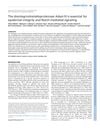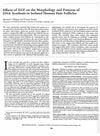Impaired Notch-MKP-1 Signalling in Hidradenitis Suppurativa: An Approach to Pathogenesis by Evidence from Translational Biology
January 2013
in “
Experimental dermatology
”
Notch signaling γ-secretase NCSTN PSEN1 PSENEN epidermal homeostasis hair follicle homeostasis follicular hyperkeratosis cyst formation chronic inflammation macrophages dendritic cells CD3+ T cells TLR2 IL-23 Th17 cell differentiation obesity smoking skin occlusion gamma-secretase T cells Th17 cells
TLDR Faulty Notch signalling may cause hair follicle changes and inflammation in hidradenitis suppurativa.
The study concluded that impaired Notch signaling, due to mutations in γ-secretase genes, played a crucial role in the pathogenesis of hidradenitis suppurativa (HS). Approximately 40% of HS patients had a family history, with mutations in genes like NCSTN, PSEN1, and PSENEN identified in familial cases. Notch signaling was essential for maintaining epidermal and hair follicle homeostasis, and its disruption led to follicular hyperkeratosis, cyst formation, and chronic inflammation. Mouse models with Notch deficiencies exhibited similar skin and hair follicle abnormalities as seen in HS. The study also found that macrophages, dendritic cells, and CD3+ T cells were abundant in HS lesions, with increased expression of TLR2 and IL-23, promoting Th17 cell differentiation. Aggravating factors like obesity, smoking, and skin occlusion further exacerbated inflammation. The document concluded that disturbed Notch signaling, either due to genetic or acquired deficiencies, was central to HS pathology, perpetuating inflammation and structural damage in the skin.

